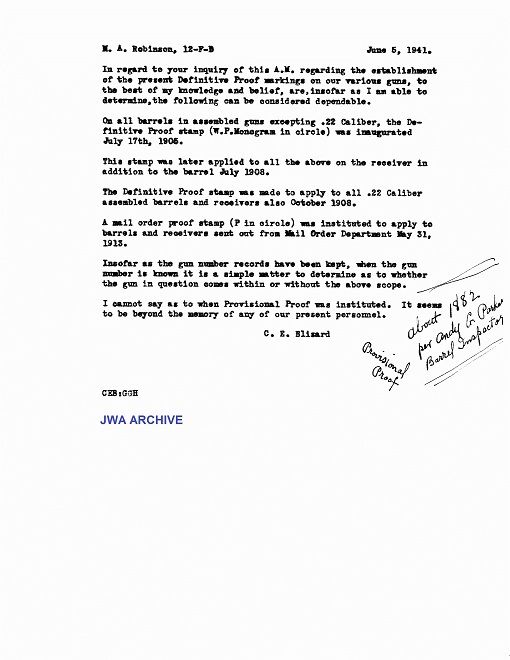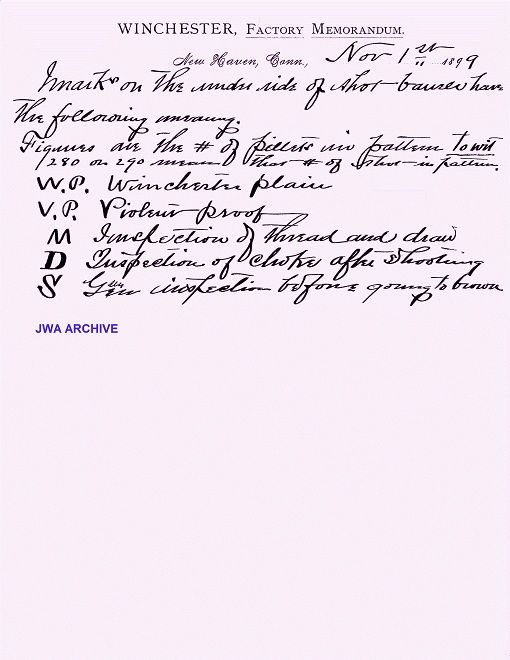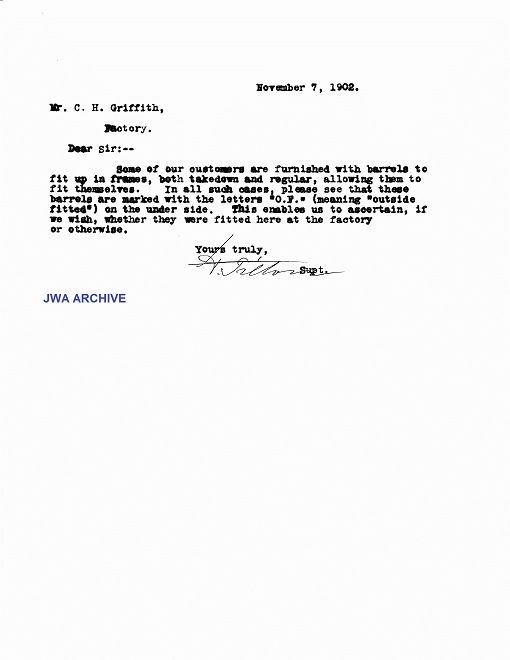Im trying to iron out in my mind a few things regarding the proof markings after reading the post regarding the 1892 with the “Oval P” marked receiver, and other forum discussions on this topic.
After 1905, Winchester began stamping barrels, and then receivers, with the “WP” Winchester definitive proof. The definitive proof meant that the firearm was so marked subsequent to its passing tests utilizing a heavy proof load—Winchester’s system of expressing that the barrel or receiver met the existing standard. Or is there more to it?
As I have read, the barrels began to receive the “WP” at around 1905, and then by 1908 both the receiver and barrel were stamped with the “WP”. Were assembled receivers and barrels proved as a unit (to receive the “WP”), or were barrels proved using a test receiver? If tested as an assembled receiver & barrel, I could understand stamping both at the same time, but at what point is the proof applied, subsequent to the final steel polishing but prior to the bluing?
At what point was the “Circle VP” for “Viewed Proved” stamp applied to the underside of the barrel–following the heavy load testing, the “VP” being applied after the visual inspection of the barrel? The “VP” is found on every 1892 and 1894 barrel I have seen from the start to the end of production, bridging the date for the appearance of the “WP”. Then why the addition of the “WP”—I admit I am no history buff, just curious regarding the reasoning for the “WP”.
Since there has been a lot of discussion regarding “WP” and “Oval P” markings and it’s a little confusing, at least to me. I tried to list the varying scenarios for its occurrence or what may be encountered (Im sure I missed a few), to which I greatly welcome comment.
For firearms made prior to 1905 (or the time standardized application of the “WP” proof on barrels/receivers first appears):
- Barrels affixed to receivers have the “Oval P” proof if the barrel was made prior to 1905 and destined for fitting by someone other than Winchester (mail order).
- Firearms having no “WP” proof on the receiver but have affixed barrels with “WP” proof mark, in addition to the “Oval P” would signify that while it is an older receiver, the barrel was replaced after 1905 by someone outside the Winchester repair shop. (in addition to verification by other barrel markings)
- Firearms made prior to 1905 that have the “WP” proof mark stamped on the receiver and barrel signifies the Winchester repair shop performed work to the barrel, receiver, or other internal part.
- Are there any examples of firearms made prior to 1905 that have the “WP” on the receiver and barrel in addition to the “Oval P” on the barrel? If so, this would signify a mail order barrel being installed by the Winchester repair shop.
- Barrels having the “WP” proof mark but no “Oval P” would indicate a potential non-mail order barrel swapped outside the Winchester repair shop.
For barrels & receivers made after 1905:
- Receivers having the “WP” proof but no “WP” or “Oval P” proof on the barrel would indicate the barrel was replaced outside of Winchester using a pre-1905 barrel.
- Receivers without the “WP” proof but have barrels with the “WP” proof fall into that period from 1905-1908 where the barrel may have the “WP” proof but the receiver will not.
- Receivers made after 1905 having no “WP” proof but have barrels with the “WP” and “Oval P” mark would indicate a mail order barrel.
- Firearms having the “WP” proof on the receiver but not on the barrel, the barrel having only the “Oval P” would indicate an older stock mail order barrel. If the “WP” proof was an indicator of Winchesters subjection of the barrel or receiver to proved testing, why wouldn’t the “WP” appear along with the “Oval P”?
- Receivers and barrels having the “WP” in addition to the “Oval P” on the barrel would indicate a mail order barrel fitted outside the Winchester repair shop.
- Are there examples having the “WP” on receiver and barrel in addition to the Oval P on the barrel that have an R&R note? If so, do they occur pre-1905 or post-1905 or both?
I understand the R&R entries in the ledgers but am uncomfortable in believing there will be an entry for each and every return to Winchester for the repair. While this may have been the rule, there certainly could be exceptions, after all, we have each found things that weren’t supposed to be present in living color. I picked up on an older topic/post where others that have stated that a barrel having the “Oval P” could have been fitted by Winchester:
https://winchestercollector.org/forum/winchester-rifles/Age+of+replacement+barrel/#p41517
Just a curiosity, any comments are welcome, as are those to the contrary. Maybe we can find some consensus, or not.
1892takedown @sbcglobal.net ......NRA Endowment Life Member.....WACA Member
"God is great.....beer is good.....and people are crazy"... Billy Currington
I think in part, but probably not the whole function or strategy with using the WP stamp, was that it was somewhat of a marketing campaign. It also probably helped with the counterfeit issues that the company was dealing with at the time.
I’m sure others will have more Info, just a quick thought on the matter.
Sincerely,
Maverick
![]()
WACA #8783 - Checkout my Reloading Tool Survey!
https://winchestercollector.org/forum/winchester-research-surveys/winchester-reloading-tool-survey/
Chris,
Winchester (based on PR dates) first began using the superposed “WP” Winchester Definitive proof mark in May 1905, and continued to use it on most models from that point on. In my surveys, I have confirmed that date for the Model 1885, Model 1894, and Model 1897, and I believe that Michael has confirmed the same on the Model 1892. Winchester right from the beginning marked both the barrel and the receiver. Ned Schwing stated in his reference book on the Model 1890 & 1906 that Winchester began proof marking them in 1908… I do not know if that is accurate, but will assume that it is. The “WP” proof mark was applied after the barrel and receiver were mated, assembled and finished. This is highly evident on the firearms manufactured in the late teens through early 30s when the blue flaked (popped) off when the proof was struck on the receiver frame.
In regards to the “VP” in an oval on the underside of the barrel, I have found it on all models, beginning with the Model 1873 (I have not looked for it on the Model 1866, but my bet is that it too was marked with the “VP”). Winchester (in their catalogs) describes the process for the “VP” proof mark as follows:
quote
How Winchester Barrels Are Tested.
Gun makers agree, that the most difficult part of a gun to make is the barrel. To do so successfully, requires a thorough knowledge of the subject, skilled experts, delicate and exact machinery, and a comprehensive systems of tests. The system by which Winchester barrels are made has made them famous all over the world for their accuracy and strength. When a Winchester barrel has been “rough” bored, as the first boring is called, it is proved for strength, – soft steel barrels for black powder and low pressure smokeless powders by the English Government proof system, and nickel steel barrels for smokeless powder with a system of smokeless powder proof. All barrels are proved with either of the above systems except .22 caliber. The proof is made as follows: A soft steel barrel is locked to a firing table, loaded with a charge of powder and lead twice as great as intended to be put into the shell the barrel is to be chambered for, and fired. The nickel steel barrels are similarly tested, being subjected to a pressure 30 percent in excess of pressure developed by the cartridge the barrel is intended to be chambered for. After proof firing a barrel is carefully inspected and if it shows the slightest sign of strain, or imperfection, it is condemned. A barrel that passes the proof is next straightened, and then given the second or “finish” boring. It is then straightened again, after which it is subjected to what is known as the “Winchester” or “Lead” test, which never fails to disclose any irregularity in the interior of a barrel. This test is repeated after the barrel is rifled, for the purpose of detecting any possible disturbance of the bore during the latter process.
end quote
The above paragraph first appears in the November 1897 catalog No. 60, and was repeated in all catalogs through the 1916 catalog No. 80.
Based on what I have observed and read in other sources, the oval (P) proof mark was not introduced until 1908. Prior to that time, Winchester marked “OF” (outside fitted) on the bottom of the barrel under the forend stock for the mail order barrels. I have see several of them on Model 1885 Single Shot Rifles that predate 1908.
To the best of my knowledge, if you find a pre-1905 Winchester with a “WP” proof on the barrel, but not on the receiver, somebody other than Winchester swapped the barrel. It is possible to find a pre-1908 Winchester with a proof on the receiver, but nothing in plain sight on the barrel. In that scenario, I would first check the serial number for an R&R, and pull the forend to check the bottom of the barrel.
I personally am not of the opinion that Winchester ever used mail order barrels in the factory to complete or fill orders. Doing so would imply that they had run completely out of regular production barrels… if that happened on a regular basis, somebody (the shop foreman) needed to be fired, or fire the person in charge of making sure that the assembly room workers did not run out of the necessary parts needed to build guns. I just can not believe that it was necessary to take parts from the store room designated for mail order parts. Any foreman worth his paycheck would make sure the parts supply stayed ahead of the assembly line!
My two cents,
Bert
WACA Historian & Board of Director Member #6571L
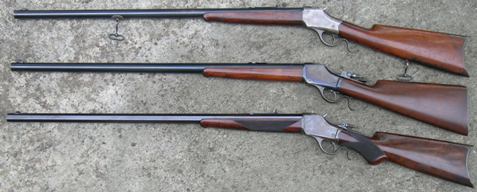
Thank you Bert for the additional information. I wasnt aware that both the barrel and receiver were struck with the “WP” from the inception of using the “WP” proof, nor that the “Oval P” didnt appear until 1908. I thought there was a span of time where it was the barrel and not the receiver, but likely got that mixed up with the 1890 info. Thanks for clearing that one up. I am still curious about the reasoning behind the WP’s use at that point in the game.
Chris
1892takedown @sbcglobal.net ......NRA Endowment Life Member.....WACA Member
"God is great.....beer is good.....and people are crazy"... Billy Currington
In Manufacturing process , parts are produced in quantity, justifying the required overhead cost of setup time for the operation . Total Numbers of the run are the combination of the requested quantities ,determined by different department heads , and delivered to those departments upon completion. The component parts produced in this documented run are not different from one another , as they are manufactured to the tolerances set out by the Master Blue print . Subsequent operations are performed as required by the department ,as in the case of Mail order to be proofed separate from a mated unit, and proof stamped accordingly (Oval P in the case of barrels and receivers )
If a re-barreling order came in in later years for a barrel in a discontinued production caliber, production , take down of an existing run or busy schedule could not be justified for the sake of a one off piece set up, making the order impractical , unless an old stock component was still in stock , such as in mail order department, with the added benefit of getting paid for an obsolete item instead of taking up space and finally scrapping
I have been entertained and broadened by the information contributed tirelessly by Bert and other experts on this forum, and will also try to contribute , but will try to not comment on subjects I dont know about
Phil

25-20 said
If a re-barreling order came in in later years for a barrel in a discontinued production caliber, production , take down of an existing run or busy schedule could not be justified for the sake of a one off piece set up, making the order impractical , unless an old stock component was still in stock , such as in mail order department, with the added benefit of getting paid for an obsolete item instead of taking up space and finally scrapping
Phil
Not to say I’m an expert on the whole “Mail Order Replacement Barrel” Debate. But with your statement above, you make it sound like Winchester was some back door Mom & Pop gun company. And that they didn’t have any room to spare, or wouldn’t of maintained stockpiles of components and parts. Or if they ran out of a part that was obsolete that they couldn’t or wouldn’t re-make it.
I think a factory with 3.25 million square feet of floor space had plenty of room to do all that it needed and wanted to. I doubt it would of cost all that much to go tell the experienced barrel shop guy, hey make me up this obsolete caliber in this length and for this model rifle. I imagine Winchester would of kept and maintained the barrel chamber reamers for all the various 271+ calibers that they produced. Along with plenty of barrel blanks laying around.
This is from a 1916 brochure of the factory’s goings-on.
So I imagine if a customer needed something done they would of accommodated them. Back when a Company’s name and reputation actually meant something.
Sincerely,
Maverick
![]()
WACA #8783 - Checkout my Reloading Tool Survey!
https://winchestercollector.org/forum/winchester-research-surveys/winchester-reloading-tool-survey/
For the Model 1892 rifles Winchester began consistently applying the “W/P” proof stamp on both the barrel and receiver during 1905 right around SN 300,000. I have found several earlier rifles (1902 and 1903 serial number application date) that are proofed but after checking the ledgers these rifles were not fully assembled and in the warehouse until after the 300,000 SN dates. In other words, the receivers were made and sat around for a few years before being assembled into full rifles and thus tested and proofed after the practice was common procedure. This is an important point as it points to a few practices of the manufacturing process. 1. Winchester obviously had LOTS of room for parts to be stored for extensive time before use. I have found many late production rifles that have a mix of barrel stamp styles which implies that much older barrel were finally used and marked in the newer manner common at the time of assembly. and 2. Parts were obviously not used on a “first made/first used” basis. Compared to todays manufacturing efforts these practices sound extremely inefficient.
I can not determine exactly when the “Oval P” was first used based on my work but I can make this observation. The Oval P proof stamp is only found on barrels which have a Style 3 barrel address which is located on the left side of the barrel. This position was not common until 1910 for the Model 1892 rifles. No barrel which has one of the earlier barrel address styles or top of barrel positions are marked with an “Oval P” proof. There obviously could be rifles with non original barrels put on by non factory shops but they would not be marked or noticeable unless the barrel address is significantly out of sequence. This would suggest that the “Oval P” proof was not introduced until 1910. You can look here for address styles:
http://forums.gunbroker.com/topic.asp?TOPIC_ID=606355
Michael
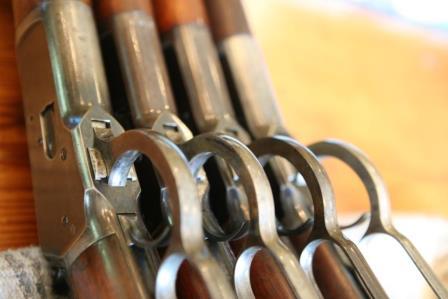
Model 1892 / Model 61 Collector, Research, Valuation
The concept of Successful manufacturing is not very complicated
It starts at the top level with the top bosses concerned with maximum profit thru efficiency and expediency , that they pass down the chain of command. Making order processing more complicated and costly is not part of the process at any level.
In a simple replacement issue, making new parts from scratch ,if the ordered replacement part with correct configuration, is already in the factory is not a viable option
An exception to standard procedure may occur in the odd instance of production of a Presentation Gun
Phil

Bert H. said
Winchester (based on PR dates) first began using the superposed “WP” Winchester Definitive proof mark in May 1905, and continued to use it on most models from that point on. In my surveys, I have confirmed that date for the Model 1885, Model 1894, and Model 1897, and I believe that Michael has confirmed the same on the Model 1892. Winchester right from the beginning marked both the barrel and the receiver. Ned Schwing stated in his reference book on the Model 1890 & 1906 that Winchester began proof marking them in 1908… I do not know if that is accurate, but will assume that it is. The “WP” proof mark was applied after the barrel and receiver were mated, assembled and finished. This is highly evident on the firearms manufactured in the late teens through early 30s when the blue flaked (popped) off when the proof was struck on the receiver frame.
Bert
Hi Bert,
Schwing is correct with the 1908 date for the .22 rimfire models. Although Winchester had been proofing the centerfire rifles since 1905 most of the rimfire models were not proofed using that system until 1908. The impetus for marking the .22 rimfire models was driven by a new import requirement of Australia. There is a whole folder full of correspondence at McCracken regarding the new (1908) import proof requirements and how Winchester was able to meet the requirements. Basically, by proofing and adding the WP marking, along with an affidavit from Winchester certifying the process, they were able to avoid having the rifles proofed outside the US. When the decision was made to proof mark the .22’s for Australia it became a universal requirement for all of the rimfire line. If you or anyone else gets a chance you should review the correspondence folder, while it does not pertain to the centerfire rifles which were already being marked, it is VERY interesting reading for the background of the .22 rimfire line.
Best Regards,
WACA Life Member #6284 - Specializing in Pre-64 Winchester .22 Rimfire
Glad to share! I copied most of the interesting stuff from the folder but for those who don’t want to dig through the archives looking for it, the Australia folder is located in MS 20, Series 10, Box 23, Folder 14. It includes the sworn affidavit of Winchester Bennett (2nd VP of Winchester) attesting to the proof process as well.
To get us back to the topic at hand, while looking through my notes for the rimfire WP, I found the Winchester letter from C.E. Blizard dated June 5, 1941 which states that “all barrels in assembled guns excepting .22 caliber” were definitive proof marked (WP) with an inauguration date of July 17, 1905. It also states “A mail order proof stamp (P in a circle) was instituted to apply to barrels and recievers sent out from the Mail Order Department May 31, 1913″.
While there have been some plausible theories presented here and elsewhere we may never know the answer to the original question about the receiver with both marks shown in a previous post. Based on other replacement barrels I have seen which include both the WP and mail order P and a statement from a former Winchester employee that indicated they DID use some mail order parts when rebarreling rifles returned for service I suspect that it is a replacement receiver which was installed and proofed at Winchester and the mail order proof was also added to simply indicate it was not the original receiver. That is just my opinion/guess.
Hope that helps.
Best Regards,
WACA Life Member #6284 - Specializing in Pre-64 Winchester .22 Rimfire
Jeff,
Simply stated, AWESOME information!
For the center fire models, the dates I came up with were based on the PR dates for the serial numbers found, and considering the typical lag time between serialization and completed assembly, the July 17th, 1905 date makes absolute perfect sense.
The mail order (P) date of May 31st. 1913 also matches up very well with what Michael has observed in his extended research of the Model 1892. I am going to correct my notes with the information you have so graciously provided to all of us… THANK YOU VERY MUCH!!
Bert
WACA Historian & Board of Director Member #6571L

If it were possible to edit my earlier reply I would change the introduction of the “Oval P” stamp to read “not found until 1910 or later.” Thus the 1913 date is a great fit.
I can not determine exactly when the “Oval P” was first used based on my work but I can make this observation. The Oval P proof stamp is only found on barrels which have a Style 3 barrel address which is located on the left side of the barrel. This position was not common until 1910 for the Model 1892 rifles. No barrel which has one of the earlier barrel address styles or top of barrel positions are marked with an “Oval P” proof. There obviously could be rifles with non original barrels put on by non factory shops but they would not be marked or noticeable unless the barrel address is significantly out of sequence. This would suggest that the “Oval P” proof was not introduced until 1910 or later.
Michael

Model 1892 / Model 61 Collector, Research, Valuation
Also, you guys have probably already seen this info but here are scans of the 1899 Winchester Memorandum describing the marking system on the underside of the barrels (at that time).
Additionally, I have scanned the internal factory directive which describes the use of “OF” for outside fitted.
I don’t mean to clutter up this thread but figured I would post them for those guys that hadn’t seen the info.
Regards,
WACA Life Member #6284 - Specializing in Pre-64 Winchester .22 Rimfire
Its a great day when you uncover that little nugget of truth. I greatly appreciate all who have contributed to the topic.
Chris
1892takedown @sbcglobal.net ......NRA Endowment Life Member.....WACA Member
"God is great.....beer is good.....and people are crazy"... Billy Currington
1892takedown said
Its a great day when you uncover that little nugget of truth. I greatly appreciate all who have contributed to the topic.
Chris
Amen!! An now to have the head stone made for any more arguing about what these marks were intended for!!!
Michael

Model 1892 / Model 61 Collector, Research, Valuation
The Winchester Model 92 octagon barreled Saddle Ring Carbines, (about 100 or more) ordered by Paramount Movie studio’s in the 1930’s prove that Winchester did use the Oval P on guns that Winchester re-barreled at the factory. Research on this variation was done by Leroy Mertz. All examples have the same reworked and cut down barrels that are proofed with the mail order and VP proof marks. Since dozens are known, it is just too many and too well documented to be a chance happening. Anyone who has actually worked or managed production on the shop floor of a large production and manufacturing company knows that a correct new replacement part or barrel would Not be available in every instance. And no factory would ever produce one from scratch if there was an oval P barrel available for instant use. My own Paramount movie SRC has been family owned since 1939 and is identical to the 5 others I have personally examined.
This thread has been a great help and has put my mind at ease with respect to the proof markings on a Model 1894 which I am currently restoring. The rifle was manufactured in 1911 and, based solely on my knowledge of Model 1890 rifles, I had thought that my ’94 should not have had proof marks on either the barrel or receiver but it has both.
It also gave me confidence that my early Model 1892 also has the correct proof markings for its age ie none.
Very interesting information in the factory letters regarding the export of rifles to Australia and the requirement of the 22 calibre rifles being proofed and marked; amazing how much credibility the Winchester name carried when a phrase the likes of “our Winchester proofing is more stringent than the British” carried the day and satisfied the needs of the Australian Government.
Many thanks to all who contributed to this thread!
2 Guest(s)


 Log In
Log In Members
Members Home
Home

 Add Reply
Add Reply Add Topic
Add Topic
 Offline
Offline






